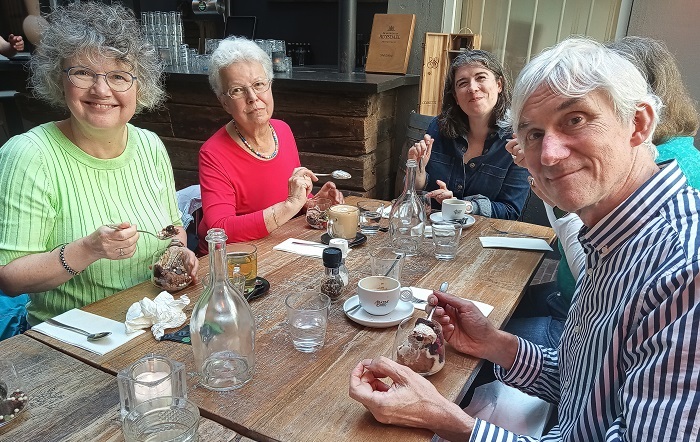
Our SENSE Summer Social began on 12 August in less than perfect circumstances – a heavy summer rain shower meant that our 17 attendees arrived wet and bedraggled, shaking off umbrellas and removing waterproof layers. Nevertheless, spirits were high, and everyone was excited and curious to see how the day would unfold!
It wasn’t long before our tour guides arrived, and we assembled at the beautiful Pandhof monastery garden of the Dom Church in Utrecht. A story was unveiled to us by our knowledgeable guides, a tale which spanned 2,000 years of Utrecht history. Large maps and diagrams were used to illustrate the ways in which Dom Square has changed over the centuries, and how it has always been the ‘beating heart’ of Utrecht. New buildings were constructed on the remains of old ones, leaving a rich archaeological legacy in the ground beneath. We discovered that the Romans came to Utrecht (which was known to the Romans as ‘Traiectum’) and constructed Castellum Traiectum in the first century. We learnt about the thriving Middle Ages of Utrecht, with its trade routes and connections via the Rhine River, and we were told how the Dom Tower came to be a free-standing tower due to the destructive force of the Great Storm of 1674.
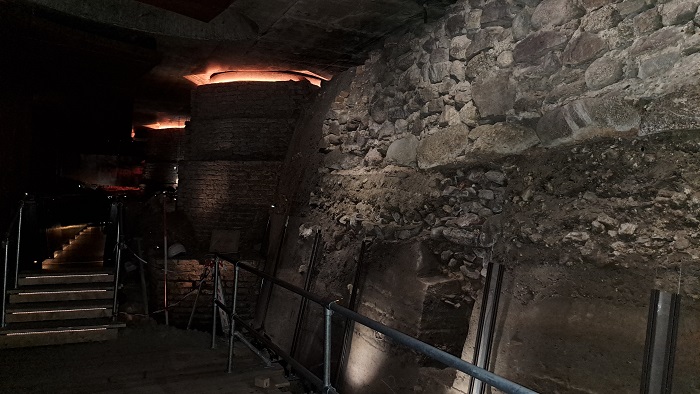 Armed with this knowledge, it was time to venture into the subterranean depths! Like amateur archaeological sleuths, we were each given a ‘smart flashlight’ and then descended underground, ready to explore. The flashlight was attached to an earpiece and, when pointed in the right place, a voice in the earpiece revealed snippets of history about the inscribed pottery, brooch pieces and other historical remains that could be found hidden in the near darkness.
Armed with this knowledge, it was time to venture into the subterranean depths! Like amateur archaeological sleuths, we were each given a ‘smart flashlight’ and then descended underground, ready to explore. The flashlight was attached to an earpiece and, when pointed in the right place, a voice in the earpiece revealed snippets of history about the inscribed pottery, brooch pieces and other historical remains that could be found hidden in the near darkness.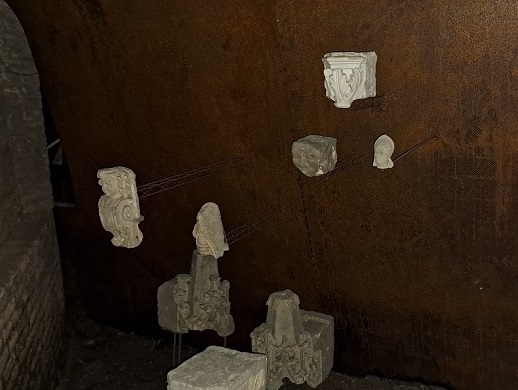
We were busy searching for clues when a thunderous sound filled the room and the caverns’ walls sprang to life, showing an animation of the Great Storm of 1674. The storm had been so fierce that it destroyed the nave of the cathedral that joined the tower and the church. These parts were never connected again, and are now separated by the Dom Square.
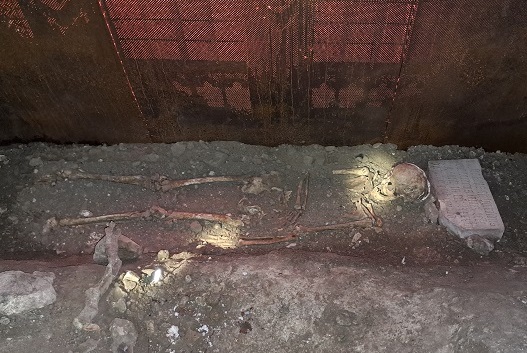
It wasn’t long before our exploration was over and it was time to climb out of the darkness, back to the land of the living. We emerged from the ground, squinting like moles in the sunlight, and were delighted to see that the rain had passed and the sky was blue.
Having worked up an appetite, lunch beckoned. As we walked to the restaurant, we were delighted to see a bronze marker below our feet, marking the ancient boundary of Castellum Traiectum. At night, a line of steam and coloured lights emanates from this boundary. Unfortunately, at 12:30 on a sunny August afternoon, we were not able to witness this spectacle.
We arrived at Ubica restaurant, where a private room awaited us along with a delicious buffet of sandwiches, salads and desserts. After being stuck in the depths for an hour, everyone was eager to catch up and have a chat, and the room was filled with noisy chatter and laughter.
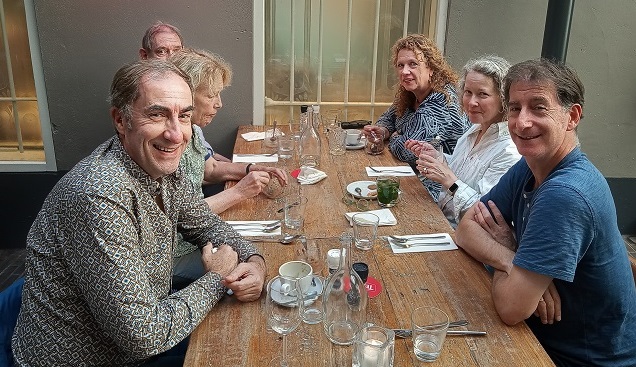
During the lunch it was great to learn a bit more about the experiences of other SENSE members, to find out what people do, both in their language work and in their daily lives. For me as a new SENSE member, it was wonderful to meet new people, some of whom have been SENSE members for many years.
As SIG & Social Events Coordinator, this was the first event that I’d organized, and I was delighted that the day was a roaring success. The tour was a fascinating insight into the history of Utrecht, and the ‘smart flashlight’ turned the DOMunder experience into a fun adventure!
|
Blog post by: Becky Tomas Website: bexchecks.com LinkedIn: bexchecks |
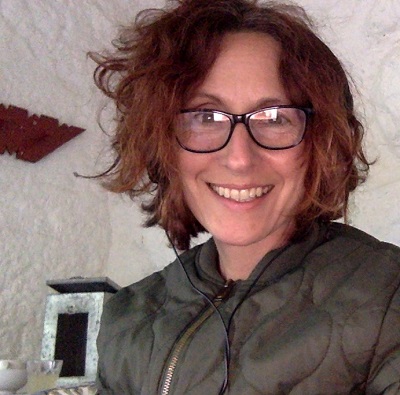 Freelance writer, journalist and media instructor Dara Colwell joined SENSE a few months ago. I invited her to share her interests and stories with us, and to talk about what moves her in life. Her answer was as expressive and engaging as the ones that follow in this interview.
Freelance writer, journalist and media instructor Dara Colwell joined SENSE a few months ago. I invited her to share her interests and stories with us, and to talk about what moves her in life. Her answer was as expressive and engaging as the ones that follow in this interview.
Can you tell us a bit about yourself and where you are from?
A professional writer for 23 years, I hail originally from Los Angeles, though I’ve lived in Europe most of my adult life. (My brother has lived in Tokyo just as long, so our parents did a stellar job instilling us with wanderlust!) I earned my Master’s degree from UC Berkeley’s Graduate School of Journalism and worked for several years as an investigative reporter at Metro San Jose in the heart of Silicon Valley. I eventually became a freelance writer, writing about the environment, politics, culture and the arts in New York City, and later in Amsterdam. I currently teach professional writing and storytelling techniques at the University of Groningen. My very first job after graduating was teaching English as a second language, so teaching comes naturally to me – especially teaching what I love: writing!
What brought you to the Netherlands?
It’s cliché but true: a Dutchie wooed and brought me here. Our story would make an excellent, unpredictable screenplay and the tagline would have to include something about persevering against all odds. I came for love, and stayed for it, and the bonus was falling in love with Amsterdam, where I was lucky to have written for (the now defunct) Amsterdam Weekly – as writing about the city’s arts and entertainment scene helped me explore it. Living in the Netherlands has given me a quality of life I couldn’t have imagined while growing up in the US and I am deeply appreciative.
Do you get on with the Dutch language?
Yes, as my partner is Dutch. I have translated several books from Dutch to English, cleaning up the ‘Dunglish’ to make the text sing. The books are ‘Becoming Whole’, about birth, death, language, karma and transpersonal therapy (yet to be published); ‘The White Field’, about a life lived in Tibet 3,000 years ago (yet to be published); and ‘Free Up and Play’, originally conceived in English but later published in Dutch, about overcoming stage fright using non-violent communication (NVC).
Can you describe your current professional activities?
Besides teaching professional and feature writing, I am currently helping a client conceptualize, write and edit a book about effective leadership in today’s business world. I generally take on diverse writing and editing projects, from revising websites to writing articles about corporate wellness. Everything interests me, though the more creative, the better.
What are your hobbies? Can you recommend some books?
Cycling, cooking, making collages, gardening/permaculture, immersing myself in nature, and writing screenplays. I am a history nut and currently revamping a screenplay that takes place in the 1890s.
The books I am currently reading: Jay Heinrichs’ ‘Thank You for Arguing’, about persuasion and oratory techniques; Alain de Botton’s ‘The Art of Travel’, whose title is self-explanatory; and finally Paul Mason’s ‘Clear Bright Future: A Radical Defence of the Human Being’, which I just started, and looks at what being human means in today’s digitized world.
How did you hear about SENSE and why did you decide to join?
I have known SENSE for some time from fellow writers/editors. I decided to join to expand my network, learn more about who is involved, and hopefully, find more work. I am eager to network, meet fellow writers and editors to talk shop, and I am always open for job opportunities. I am full of stories and eager to hear yours, professionally or otherwise.
|
Blog post by: Paula Arellano Geoffroy Website: paulaarellanogeoffroy.com LinkedIn: paula-arellano-geoffroy |

On 1 June 2023, Rachel Pierce, a US-based freelance translator and copywriter, spoke to a packed Zoom meeting of the SENSE Tech SIG about ChatGPT. While many of us have dabbled with ChatGPT, it was Rachel’s recent article for the American Translators Association (ATA), ‘5 Tedious Non-Translation Tasks ChatGPT Can Do Amazingly Well’, that prompted the invitation to her so we could learn some practical ways to take advantage of this rapidly evolving technology. In the meeting, Rachel outlined how to use ChatGPT’s capabilities for tasks that can help language professionals maximize their productivity, while also acclimatizing to the inevitable changes coming to language professions as a result of generative artificial intelligence (AI) technology.
Language professionals are the most qualified users
Rachel acknowledged from the start that it’s quite overwhelming to keep up with what is happening. This technology is spurring the introduction of new tools and integrations every week. But she emphasized that ‘As linguists, we’re uniquely qualified to assess how good the tools are, and to find unique ways to use them.’ We’re encouraged to jump in and start testing their limits. A lot of the tools we use every day like Microsoft Word have incorporated AI functionality already. Think about Microsoft Editor or the auto-complete feature. Rachel mentioned Microsoft 365’s new digital assistant, Copilot. This is a ChatGPT-powered interface that Microsoft is integrating into its Office applications this year. Translators have been using machine translation tools that incorporate AI technology for several years. Following the launch of ChatGPT, many professionals are now looking at how they can incorporate new AI tools into their language-related workflows. As Rachel says, ‘It’s coming whether we want it to or not.’
Tools that automate ChatGPT
Rachel discussed a few tools she’s been sampling that interface with ChatGPT. She mentioned Wordscope, a web-based multi-functional translator’s toolkit that uses buttons to interact with ChatGPT and send it pre-written prompts for various tasks. Gaby-T is another app built to automate ChatGPT interaction for language professionals. These are but two of many tools now available either as a plug-in within ChatGPT or as a browser app or web-based app. In short, these tools automatically generate complex prompts so we don’t have to be ‘prompt engineers’ to leverage the chatbot’s ability to process sophisticated instructions. But Rachel also suggested that it’s good to learn some prompt-writing skills, reminding us that we all learnt how to use search engines 20 years ago – ‘We’re already good Googlers, so we can learn how to talk to a chatbot.’
GPT 3.5 versus 4.0
The second half of the presentation focused on best practices, caveats and demonstrations of different tasks that applications using GPT can do. Rachel briefly mentioned some differences between the two language models currently available on the software site: GPT 3.5 is free and faster, but trained on less data so best used for simpler tasks; GPT 4.0 (subscription only) is trained on exponentially more data, so it handles complex instructions better and its responses are much more accurate.
Shortcomings
ChatGPT’s shortcomings are notable. An important one is the lack of training on data after September 2021, which limits its ability to generate responses containing more recent information. Another is its tendency to ‘hallucinate’ – to generate responses that sound true but are riddled with fabrications. For example, it is known to make up citations. Hence, a key best practice is to verify any information it reports. And because it has no privacy safeguards, it’s important to check our non-disclosure agreements before pasting anything into ChatGPT that shouldn’t be shared.
Best practices
ChatGPT performs best when given context for the instructions and also a format for the output. We must describe the purpose of the text/response desired and how long or short it should be, as well as the style or tone. And make use of the different ways to refine responses – either by providing further instructions, or using the regenerate button.
Time-saving tasks
Shortcomings aside, Rachel took us through a demonstration of how she uses ChatGPT with a dozen simple prompts. We watched ChatGPT generate its responses as she went through various scenarios that any of us might do in the course of our work, such as finding alternative/substitute words; making grammar and style decisions; comparing and contrasting at a higher level; summarizing an article, book or other text; creating and then redacting; organizing your thoughts; and clearing writer’s block.
One of the most interesting of these was summarization. Need to research a topic quickly? Rachel demonstrated how to paste in the text of an article and ask ChatGPT to summarize it into one or several key points. (Note the limits: up to 3,000 words per prompt with GPT 3.5 and 25,000 words with GPT 4.) She also used the browser with Bing plug-in to retrieve the text of two academic articles from the web for ChatGPT to summarize. The plug-in automated the retrieval, submission and summarization of all the requested articles into one command. Other big time-savers were having it organize a set of talking points for a networking event and a presentation. It also can help clear writer's block. In one example, Rachel asked it to generate captions for a dozen images of a fitness centre. It provided a list of options so she didn’t have to come up with a dozen on her own. These are a few ways ChatGPT can help writers get ‘creatively unstuck’.
Further inspiration
The results were impressive and gave many of us new ideas to experiment with. We appreciated her key takeaways for language professionals in navigating this moment:
- Clients are also overwhelmed – it’s a good time to start a conversation with them about their AI plans.
- Stay on top of how your preferred tools are incorporating AI – follow their companies, and take advantage of the free webinars that are happening.
Questions and comments were diverse, from ‘What is it doing when it regenerates?’ and ‘Why does it hallucinate?’ to whether the output generated can be detected by plagiarism checkers. One academic copy-editor asked whether it really saves time if we have to check the accuracy of everything it generates. Perhaps the best answer is the well-known adage ‘user experience may vary’, but as language professionals, it’s important to understand both the capabilities and shortcomings of the tools we use. Especially when they are changing the landscape in which we are working.
|
Blog post by: Susan Jenkins Website: stjenkins.com LinkedIn: susantylerjenkins-connect |
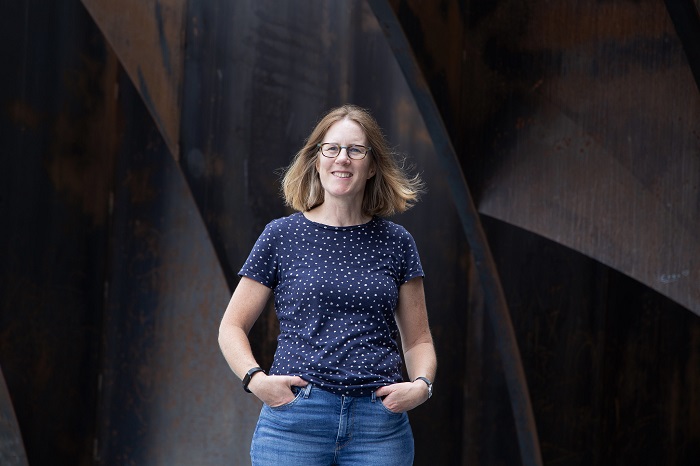
Those of you who know me were likely unsurprised when I became Chair of the SENSE Executive Committee (EC) in March 2022. I had been a member for well over ten years, attended lots of events, been a regular presenter and a SIG convener. I was also vocal at general meetings and active on the Forum. In sum, a familiar face who cared about SENSE, its members and the quality of professional English in the Netherlands.
But of course, serving on a committee has to fit in with the rest of your life. While I can just about plan EC business around my job and personal life and other volunteering commitments, I sometimes feel the frustration of not being able to do more. In an ideal world, an organization such as SENSE has someone at the helm who can lead the way, inspire others, innovate, make connections, be on top of trends in the language industry, and maintain regular contact with other SENSE volunteers. But we also need to be practical – that’s just not feasible for most people, and so – like other EC members – I do as much as I can.
Over the past year, the EC has nevertheless accomplished quite a lot. I am most proud of the fact that we are a stable team with all EC and Team Leader (TL) positions filled. It’s also good to see the EC making progress on two long-term projects that are essential to the running of SENSE but perhaps less visible to the wider membership. Firstly, the repercussions for SENSE of the WBTR legislation have required careful consideration. Discussions on this started before I joined the EC and will likely continue for several months. One major consequence is that the EC now has just five members, and this means that EC meetings have more of a focus on Society business, such as management, compliance and finances, and less on event planning for example. Outside these meetings, we get a considerable amount done online together with the leaders of the Content team, Social Media team, CPD team, SIG and Social Events team, and Website team.
The second longer-term project that is taking shape is the website – this needs a revamp but also a major update to the underlying software. Because this will be a pricy undertaking, we don’t want to make any hasty decisions, but we’re hoping to have most of the work done by the end of 2023. I’ve had contact with web support companies and web managers of other societies, for example, to get a better idea of how to approach things and support our Web Manager with this project.
What else have I been up to since becoming Chair? Well I’ve been chairing the EC meetings (held every two months), and I chaired the Annual General Meeting for members in March; I was active in finding SENSE members willing to sit on the EC or become a Team Leader; I’ve met with people from other professional societies, such as NEaT, EASE, iPED, MET, NGTV, VZV, and VViN; and I’ve helped finalize the Dutch Convenant available in our Library and commission and review an English translation of it.
I also set up a new free event for members called SENSE Orientation which we hope to hold twice a year, alternating between in person and online. Attendees can familiarize themselves with our Society and hear how to get the most out of the SENSE membership – the next session is on 2 September in Utrecht.
To summarize, the first year and a bit has gone by pretty quickly, and I’m really enjoying working together with other enthusiastic volunteers to get things done within SENSE – each in our own way of course. I’m encouraged to see that many SENSE members are once more coming along to in-person gatherings in this post-Covid era, and I hope that some will also be willing to come forward with new ideas and enthusiasm to shape the future of our Society as we adapt to changing times.
|
Blog post by: Sally Hill LinkedIn: sally-hill-nl Twitter: SciTexts |

The Chartered Institute of Editing and Proofreading (CIEP) publishes a series of guides that are free for its members and can be purchased by non-members on topics related to copy-editing and proofreading. In 2021, I took a big leap out of my comfort zone and wrote a CIEP guide on Editing Scientific and Medical Research Articles.
Overcoming imposter syndrome
I had been aware for a while that, of the many top-quality guides on editing and proofreading offered by the CIEP, none tackled the specific field of scientific and medical editing. I also knew that this was a gap I could fill, but felt pretty nervous about submitting a proposal to the Information Team because of imposter syndrome. Once I became an Advanced Professional Member of the CIEP at the end of 2020, I was fully eligible to write a guide and had no more excuses. I bit the bullet, submitted my proposal, and was both delighted and terrified when the CIEP Information Team accepted it and sent me a contract to write the guide.
Working with the CIEP
The CIEP’s Information Team were a joy to work with. They were professional and encouraging through the whole process, pointing out what needed to be improved while applauding everything I was doing right. The result was that I learnt a lot and gained much-needed self confidence. The guide went through several rounds of editing and peer review, so I was confident that the end product was sound and fit for purpose.
What to include?
CIEP guides should offer a basic introduction to the knowledge and skills needed in a particular field. My intended audience were copy-editors who work or want to work on scientific research articles, and I knew that these people would already have a scientific style guide on their bookshelf. So what else could I offer? I decided to share my experience as both a former academic who published her own research and as an experienced scientific copy-editor who helps scientists get their papers ready for peer review. For example, I gave tips on dealing with academic clients, explaining that most scientists do not know the differences between copy-editing and proofreading and that we need to use our expertise to make sure our client gets the help they really need. I also talked about how a research paper should be structured and what typically goes wrong based on the papers I have edited over the years.
The result
The end result of one year of writing and editing was more than 50 pages explaining how to help scientists overcome common problems with writing (such as using tenses correctly, dealing with common confusables, and avoiding plagiarism) and navigate the publication process (including tips on writing pre-submission enquiries, cover letters, and rebuttal letters). The guide also includes chapters on how to edit research articles (with a detailed workflow for the beginner) and how to ensure that a research paper has a logical and coherent structure (with templates for the different sections of a research paper). Many editing colleagues have been kind enough to get in touch and tell me how helpful they found the guide.
The rewards
Writing a guide for the CIEP was a very rewarding process. If you are an Advanced Professional Member of the CIEP and have an interesting idea for a guide, I strongly encourage you to get in touch with the CIEP’s information director at information@ciep.uk.
|
Blog post by: Claire Bacon Website: www.baconediting.com LinkedIn: dr-claire-bacon-397858103 |
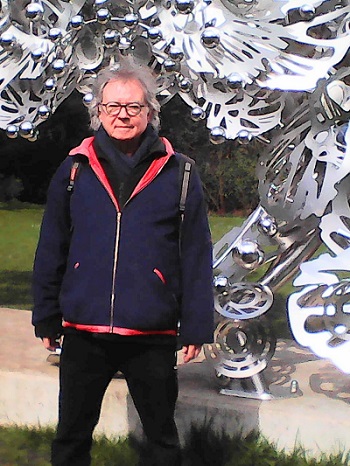 SENSE member Michael Dallas (on the left, photographed by Sheila Gogol at Beatrixpark in Amsterdam-Zuid in 2021) has been actively contributing to the Society since he joined many years ago. His numerous and informed editing and translation suggestions posted to the Forum on our website have helped many SENSE members. But his contribution goes beyond that, as he is the compiler of a supplement to the Van Dale Dutch-English dictionary, colloquially known as the ‘Van Dallas’, available in our Library. In the following interview, Michael shares with us a bit of his history and how he began compiling his extraordinary supplement.
SENSE member Michael Dallas (on the left, photographed by Sheila Gogol at Beatrixpark in Amsterdam-Zuid in 2021) has been actively contributing to the Society since he joined many years ago. His numerous and informed editing and translation suggestions posted to the Forum on our website have helped many SENSE members. But his contribution goes beyond that, as he is the compiler of a supplement to the Van Dale Dutch-English dictionary, colloquially known as the ‘Van Dallas’, available in our Library. In the following interview, Michael shares with us a bit of his history and how he began compiling his extraordinary supplement.
Can you tell us about your professional background?
I joined SENSE in 1995, shortly after I started translating and editing professionally in the social sciences and social work. I soon also developed a specialization in mental health, mainly epidemiology. All those fields had plenty of jargon that I needed to keep track of. I had previously held clerical jobs in the Universiteit van Amsterdam’s Faculty of Social Sciences, where I had gained some experience on the side working with researchers on their English publications.
I understand that you once had dual American-Dutch citizenship. What brought you to the Netherlands and what made you stay?
I decided to emigrate from the US while doing my ‘junior year abroad’ in England. I would have chosen England, Germany or Denmark as my destination, but I later made four Dutch friends in New York who persuaded me to move to Amsterdam. They met my boat at the Amsterdam Passenger Terminal and helped me learn Dutch and find housing, work and friends. From the very beginning, I planned to settle in Amsterdam for good. That was almost 50 years ago. I identify as Dutch or European, not as American. I gave up my US citizenship about ten years ago, after the Dutch banks started imposing restrictions on US citizens.
Your supplement to the Van Dale Dutch-English dictionary has more than 700 pages of original and useful Dutch terminology translated to English. Can you tell us about the genesis of this impressive list? Have you thought of publishing it?
The idea originated about 20 years ago when SENSE member Joy Burrough announced on the Forum that some of her reference books had been destroyed by a fire in her office. I pulled out my Van Dale NE (which was already falling apart) and realized how vulnerable it was. I had jotted notes down the margins of almost every page.
Although digital terminology systems already existed then, I preferred a hands-on approach. I decided to transfer all my margin notes into a Word document that could be stored externally. I had just acquired a voice recognition program, so I first dictated lists of Van Dale entries section by section, then switched to English, repeatedly said ‘move down three’, and then dictated the English translations under the Dutch words. I was surprised how smoothly that went. The original version looked much like the current one, but it had only 400 pages. I was mainly concerned with specialized jargon, but also with difficult-to-translate expressions like aansluiten op/bij.
Theoretically I could have tried to further manicure and publish the list, but that seemed like too much work and stress, so I began sharing it with colleagues. I’ve developed the habit of plucking new entries from various sources, often the SENSE Forum. Working for academics, I don’t have many rush jobs, so I have time to contemplate and note down possible translations. Many of the English terms listed are a result of ‘thinking out loud’ while translating.
You are an editor and a translator from Dutch to English who also has a Bachelor of Arts in German. Are you appreciative of multilingualism? Why?
When I obtained my BA in German in New York, I was mainly just interested in moving to Germany. In Amsterdam I earned a Bachelor's in sociology, and that was more serious. But remembering my unfulfilled ambition to live in Germany, I rented a pied-à-terre in Berlin 17 years ago, where I stay about half the time. I belong to a translators’ forum and Stammtisch. I wondered at first whether I could work in German, but in practice I’ve kept working for Dutch clients only. I no longer think I’ll ultimately settle in Berlin.
I realized the value of multilingualism when I took Latin (my first foreign language) in high school in the US. I’ve found that learning the grammar, structure and vocabulary of another language gives you tremendous insights into your native language. Since then I’ve dabbled in Spanish, French, Danish and Czech, but Dutch and German are the only foreign languages I speak fluently.
What have you found in SENSE that has made you stay a member for so long?
I’ve only held one office in SENSE, that of Membership Secretary 25 years ago, but I’ve long contributed my insights about vocabulary and rules of publication style to the Forum. In return I’ve learnt a lot from the many accomplished language professionals in SENSE, both via the Forum and at workshops and meetings. Volunteering gives me a sense of fulfilment if I believe I’m helping other people, but it also makes me more aware of what I know and do.
What do you like to do in your free time?
Nowadays I spend a good deal of my free time reading informative articles on the internet and catching up on books I’ve had on the shelves for years (e.g. I’m now reading up on Habermas). I read mostly non-fiction texts on history, society and politics. I also walk or cycle every day and travel occasionally in Europe, either alone or with friends.
|
Blog post by: Paula Arellano Geoffroy Website: paulaarellanogeoffroy.com LinkedIn: paula-arellano-geoffroy |

When I became an editor, I believed my job would mainly be spent in the study of right and wrong. Style guides and dictionaries in one hand, red pen clutched in the other, I was ready to supply grammatical and syntactical improvements. And yet, when I moved from the US to Japan and began working with Japanese companies that were writing for western audiences, I found myself spending most of my time wading through the world of subjective edits.
When editing across cultures, it becomes so much more complex than words on a page. The once-clear rules of grammar and punctuation become blurred as you switch from one version of English to another. Voice, tone, scope, and word choice are ever shifting as you consider the cultural backgrounds of both the author and the audience. How do you decide how heavy-handed to be? How do you help the author maintain the integrity of their piece while making it digestible for a foreign audience?
Unfortunately, there is no correct answer. While we can find some guidance in published literature, it is ultimately up to international editors to help the author find a successful balance for their work. For me, I’ve found that beginning with a few small things can go a long way.
1. Begin with mechanics
Does the audience use the metric system or the imperial system? American or British spelling? Adjusting the mechanics of the piece to the viewpoint of the audience can improve readability and help the author more easily connect to the intended audience.
2. Consider general knowledge
Most authors write from the standpoint of their own society’s knowledge base. The challenge is that the general knowledge of each culture is different. For example, an author may need to specify that Sir Don Bradman was an Australian cricket player when writing for American audiences or that Russell Wilson is an American football player when addressing Australian audiences. Japanese audiences will likely understand the date range of the Edo period but not that of the Irish Civil War. Helping an author bridge these knowledge gaps is essential when editing on the international level.
3. Address the goals of the author and the audience
The goals of both the author and the audience will change from piece to piece. Understanding the goals of both parties will help us successfully navigate the editing process. Is the author intending to write a text that introduces their unique cultural outlook and challenges the reader, or are they aiming to create a narrative that blends seamlessly with the audience’s worldview? Likewise, is the audience intending to learn more about a new culture or are they looking for something closer to their comfort zone?
4. Verify inclusive language
As editors, we are constantly on the lookout to avoid non-inclusive language. However, when editing internationally, we must also understand how the definition of inclusive language changes from country to country. It’s vital that we understand our audience’s inclusivity guidelines so that we can help the author avoid any unintended offenses.
As globalization continues to pull our world closer together, it becomes increasingly important for editors to be able to edit across countries and cultures. While there aren’t always clear-cut answers for this line of editing, the more we editors are able to discuss our choices, the more we can work together to ensure we are providing authors with the best edits possible.
|
Blog post by: Taylor Steed Website: taylorrsteed.contently.com LinkedIn: taylor-steed |

Those attending the SENSE 2023 Annual General Meeting this March (or reading the 2023 AGM bulletin) may have been surprised to see the announcement that the organization’s Executive Committee (EC) was being pared down to five (Chair, Treasurer, Secretary, and two Members-at-large) from eight members, with five former EC positions now designated as Team Leaders (Content Manager, Web Manager, Social Media Coordinator, SIG & Social Events Coordinator, and Continuing Professional Development Coordinator).
This change was not some draconian power grab but a move to allow the EC to focus on strategy while the Team Leaders (TLs) can focus on their respective tasks without the need to attend too many meetings, and also to better shield individual members from liability, in line with a new (well, from 2019) act called the Wet Bestuur en Toezicht Rechtspersonen (WBTR).
Compliance with the act was brought up at the 2022 AGM as well. The act applies to all associations with members (verenigingen) such as SENSE and to foundations without members (stichtingen). The WBTR’s general aim is to ensure good governance, better defined as having things run cleanly and with a minimal risk of conflict of interest and liability. The new legislation defines executive and supervisory tasks in an organization, ensures that there are provisions for dealing with EC members who can no longer serve due to illness for example, and offers a template for organizations to clarify the roles and tasks of EC members.
Under the new act, personal liability of EC members has been expanded in cases of serious maladministration, such as improper filing of accounting documents or entering into agreements that cannot be fulfilled. There is also more clarity around what constitutes individual versus group liability. In this regard, liability of SENSE has not been changed by the act, but only personal liability in case of maladministration.
What kind of liability could EC members of an organization like SENSE face? The example from last year’s meeting was a theoretical Treasurer running off with a large sum of money. Would the WBTR apply in this case? Yes, if the EC does not have clear rules and guidelines in place that would prevent the Treasurer from doing something like this, then EC members could potentially be held liable.
The WBTR also includes new rules about what to do in the event of an EC member’s absence and explicitly forbids EC members from participating in meetings or voting on issues in which they have a conflict of interest.
The EC is currently composing governance guidelines that will apply to EC members. They are also in the process of identifying the parts of the SENSE Constitution that will need to be adapted to bring them in line with the new legislation. Once complete, a draft of the updated Constitution will then be shared with SENSE members for discussion and eventually approved by the membership at a General Meeting.
------------------------------------------
Acknowledgement
Special thanks to the following contributors: Hans van Bemmelen, Sally Hill, Samuel Murray, Margreet de Roo, Curtis Barrett and Paula Arellano Geoffroy.
|
Blog post by: Anne Hodgkinson Website: rosettastonetranslations.nl Blog: bootsandbowtie.com |
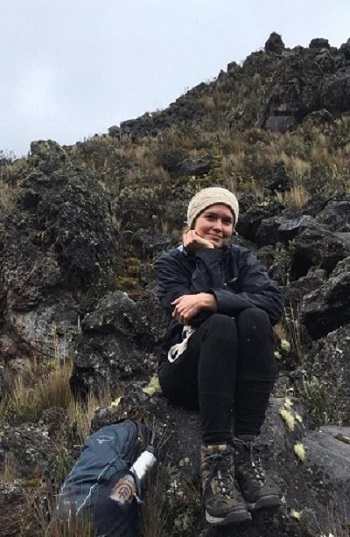 It’s always a pleasure to find people interested in writing and literature, so I reached out to fellow SENSE member Sarah Foster to invite her to share her background and interests with us and to welcome her to SENSE.
It’s always a pleasure to find people interested in writing and literature, so I reached out to fellow SENSE member Sarah Foster to invite her to share her background and interests with us and to welcome her to SENSE.
You are American, but have lived abroad for a long time. Can you tell us a bit about yourself and where you are from?
I’m originally from Virginia, but I had lived in Ecuador for most of the last ten years. I studied history and comparative literature in the US. My professional background is a mix of education, journalism, writing, and translating. I used to teach full-time. I love working with students, but I think the flexibility of freelancing is a better fit for me. I started off with a few random translating and editing jobs until I felt more confident and built up a repertoire of skills and services that I could offer. I wrote for a travel magazine, translated film scripts and subtitles, and did a few reporting projects on conservation and environmental issues in Ecuador. I recently finished a longer project developing an intercultural communication course for an NGO.
May I ask what brought you to the Netherlands and how are you getting on with Dutch?
My partner found a job here, so we decided to make the move. I was also ready for a change of pace and looking forward to more professional opportunities. I understand Dutch quite well, and I can manage most basic interactions. Watching TV shows and reading children’s books are helping me to learn more vocabulary and grammar. I hope to make some progress over the next year so that I can start to use Dutch more in professional contexts.
How did you learn about SENSE and why did you decide to join?
I have been freelancing since 2016, but I left most of my clients and professional network behind when I came to the Netherlands. I started looking for resources for Dutch freelancers. I came across SENSE and thought it would be a good way to make connections.
It must be challenging to be studying and working at the same time. How do you manage?
I’m studying in an environmental humanities graduate programme at Vrije Universiteit Amsterdam, and I also work on my freelance business. It’s been really busy, but both are important to me. Recently, I’ve done mostly fact checking, translation (Spanish-English), and editing.
I’m really enjoying my graduate school experience, and it’s helping me to specialize in environmental research. I’ve gotten to work on projects about landscapes, conservation, climate change, and environmental philosophy. If you are looking for a researcher, writer, or editor for an environment-related project, please feel free to reach out (website: sarahjanefoster.work; LinkedIn: sarah-jane-foster).
I also write poetry and nonfiction and I’d love to connect with other writers here in the Netherlands.
What do you like to do in your free time?
Well, I used to do a lot of hiking, but there aren’t many mountains around here! I’m starting to enjoy cycling, and I also like ceramics and singing.
Is there anything that you would like to share with the SENSE community?
I hope to find spaces to learn from other people’s experiences, and I’m also very happy to share my own! I’m glad to now be a part of the community.
|
Blog post by: Paula Arellano Geoffroy Website: paulaarellanogeoffroy.com LinkedIn: paula-arellano-geoffroy |
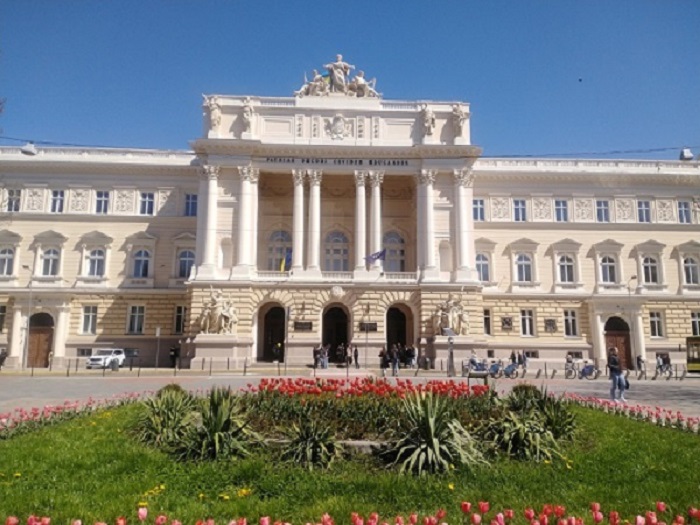
On Friday 14 April 2023, UniSIG members were joined via Zoom by Tatyana Yakhontova, professor of the Foreign Languages for Sciences department at the Ivan Franko National University of Lviv. Professor Yakhontova, who is a founder of the first Center for English Academic Writing in Ukraine and author of two textbooks on English academic writing, spoke about traditional and changing approaches to the written word in Ukraine, specifically in academia.
At the start of the meeting, the professor gave members pause for thought when she described the impact of the continuing war in Ukraine. The historic city of Lviv, though considered a relatively safe place for refugees from eastern Ukraine, is still regularly under attack. Cages erected to protect the many UNESCO sculptures in Lviv serve as a daily reminder of this context.
Professor Yakhontova spoke on the strong ‘culture of the word’ in Ukraine, and the value placed on grammatically and stylistically correct texts. Traditionally, writing was seen as a natural talent, not a skill that could be developed, and instruction was implicit. In Soviet times, copy-editing was used as a controlling, prescribing and censoring activity. Professor Yakhontova shared a personal anecdote wherein the copy editor of her first journal article drastically changed the text, and the changes made were not up for discussion. So it was in Soviet times.
After Ukraine’s declaration of independence in 1991, the world of academic writing and copy-editing began to change. There was broad support across society for a new ‘enlightening mission’ of copy editors, and the focus was placed squarely on the quality of the finished text. Notably, the original author of the text was now in a position to reject proposed changes! In the discussion that followed the talk, it was remarked how much copy-editing as a profession was valued in comparison to some other countries. Currently in Ukraine, both the copy-editing and the revision of all texts to be published are held in high regard, and almost all copy-editors are employed by publishers. This is in contrast to the freelance markets elsewhere, for example in the Netherlands and in the UK.
The reasons for these changes can be located in Ukraine’s striving for integration in Europe, the increased collaboration with US and European colleagues, and the development of applied linguistics, particularly in discourse and genre studies. In turn, these developments yield practical implications that can be used in teaching writing, and academic writing in particular.
Academic copy-editing in the English language in Ukraine is only sporadically sought out by people who work in the university system, who must publish in English ‘or perish’. However, these scholars often possess an insufficient level of English. If students are expected to write in English, for example in the case of English literature students, it is simply expected that they will know how to do so. This is also the case for many researchers, who seek writing assistance only informally. At the same time, there is increased instruction in academic writing, for example, through short training courses and writing courses aimed at doctoral students.
Concerning academic writing in the Ukrainian language, even less copy-editing support is available, which may reflect the traditional view of writing as a natural talent. At the same time, copy-editing of texts written in Ukrainian continues to be seen as a socially important activity that helps to celebrate and preserve the national language. This reflects a feeling of pride in the written word that is even more evident since the 2022 invasion.
People who attended the meeting, among whom were guests joining from outside the Netherlands, offered perspectives on English language proficiency, copy-editing and writing instruction (or lack of) in the UK, the Netherlands, Finland, South Africa, Switzerland and Kazakhstan.
|
Blog post by: Tomas Brogan LinkedIn: tomasbrogan |







